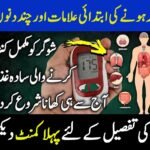The process of maintaining one’s functional ability, mental health, and overall well-being as one gets older is referred to as healthy aging. It entails adopting a way of life that encourages mental clarity, emotional stability, and physical health.


Diet is Important for Healthy Aging
Healthy aging relies heavily on diet. The right foods provide the body with essential nutrients that support cognitive function, boost energy, and prevent chronic diseases. Then again, certain food varieties can speed up maturing, prompting different medical problems.
Why Spotlight on Food sources to Stay away from After 40
The body’s metabolism slows down after the age of 40, muscle mass decreases, and the risk of chronic diseases rises. Because of this, you need to stay away from foods that can make these problems worse. Individuals can make more informed dietary choices that support improved health and longevity by focusing on what to avoid. A Brief Synopsis of the Article For better health after 40, we’ll look at 10 foods to avoid. It will discuss the negative effects of these foods, suggest alternatives, and offer advice on how to make healthier choices.
Types and Classes Foods that are processed
Meaning
Foods that have been altered from their natural state for safety or convenience are known as processed foods. This incorporates food sources that are canned, frozen, bundled, or braced with additives and added substances.
Numerous Examples
– Canned soups
– Meals that are frozen
– Crunchy snacks
– Breakfast oats
– Moment noodles
Sweet Foods
Meaning
Items that have a lot of sugar added to them are called “sugary foods.” These may result in a number of health issues, such as diabetes, heart disease, and weight gain.
Numerous Examples
– Candy
– Desserts
– Sweet beverages (like soda and sweetened tea)
– Frosting
– Energy beverages
Foods High in Sodium
Meaning
Foods with a high sodium content are those with a significant amount of salt, which is frequently used as a flavor enhancer or preservative. Consuming too much sodium can cause high blood pressure and other cardiovascular problems.
Numerous Examples
– Processed meats (like ham and bacon)
– Vegetables in a can with salt added
– Snacks with salt (chips, pretzels)
– Soups in a flash
– Seasonings (ketchup, soy sauce)
Trans and saturated fats
Meaning
Saturated fats are fats that are mostly found in animal products and are solid at room temperature. Trans fats are fats that have been made artificially and are used to make processed foods last longer. Heart disease is linked to both kinds of fat.
Numerous Examples
– Butter
– Cheddar
– Foods fried
– Prepared merchandise with hydrogenated oils
– Margarine Meats that are processed and red
Meaning
Red meats incorporate hamburger, pork, and sheep. Meats that have been preserved by smoking, curing, or adding salt and other preservatives are considered processed meats.
Numerous Examples
– Beef
– Pork
– Lamb
– Meatballs
– Dog food
Refined Carbs
Meaning
Grains that have been processed to remove the bran and germ give refined carbohydrates a finer texture and a longer shelf life. However, this also eliminates fiber and essential nutrients.
Numerous Examples
– Wholemeal bread
– Rice white
– Pasta
– Desserts
– Many cereals for breakfast
Liquor
Meaning
Cocktails contain ethanol, which can differently affect the body. While moderate utilization can be essential for a sound way of life, exorbitant drinking is connected to various medical problems.
Numerous Examples
– Beer
– Wine
– Emotions
– Beverages
– Spirits
Beverages with Caffeine
Meaning
Caffeine is a natural stimulant that can affect the central nervous system and is present in caffeinated beverages. Although caffeine can have some positive effects, excessive consumption can have negative effects on health.
Numerous Examples
– Espresso
– Tea
– Energy beverages
– Energy drinks
– A few sports beverages
Artificial sweeteners
Meaning
Synthetic sugar substitutes are used to sweeten foods and beverages without adding calories with artificial sweeteners. On the other hand, they might be bad for your health.
Numerous Examples
– Aspartame (NutraSweet, Equal)
– Saccharin (Sweet’N Low)
– Sucralose (Splenda)
– Sweet One’s acesulfame potassium
– Truvia (stevia)
Broiled Food varieties
Meaning
Seared food varieties are those cooked in oil at high temperatures. This method of cooking can add unhealthy fats and make food have more calories.
Numerous Examples
– Potato chips
– Chicken with gravy
– Donuts
– Fish fried
– Rings of onion
Signs and Symptoms
Common Aging Signs Caused by Poor Diet
A horrible eating routine can appear in different ways as the body ages. Fatigue, weight gain, and a decline in cognitive function are some of the most typical symptoms.
Effect on Levels of Energy
Devouring undesirable food varieties can prompt an absence of energy and expanded sensations of sleepiness. This frequently occurs as a result of the body’s difficulty processing and utilizing low-quality nutrients.
Effect on the Health of the Skin and Hair
An eating regimen high in handled and sweet food varieties can prompt skin issues like skin inflammation and untimely maturing. Additionally, hair can lose its luster and become brittle.
Effect on Emotional well-being
Mental health issues such as depression, anxiety, and cognitive decline can result from poor dietary choices.
Stomach related Issues
Problems with the digestive system, such as indigestion, constipation, and bloating, can be brought on by a poor diet. This is frequently because of an absence of fiber and an overabundance of handled food sources.
Causes and Chance Elements
Changes in the body after 40
As people get older, their metabolism slows down, their muscle mass goes down, and they are more likely to get chronic diseases. Dietary choices need to be more careful because of these changes. Influences from the Environment After 40, diet and health can be affected by environmental factors like access to healthy foods, cultural dietary practices, and socioeconomic status.
Way of life Decisions
After 40, a lot depends on how you live your life, like how much you exercise, if you smoke, or drink alcohol. Predispositions that are inherited A few people might have hereditary inclinations that make them more powerless to the pessimistic impacts of specific food varieties. Having an understanding of these can help you make better food choices.
Determination and Tests
Blood Tests
Blood tests can assist with recognizing supplement lacks, cholesterol levels, and different marks of dietary effect on wellbeing.
Evaluations of the Diet
Dietary appraisals include assessing a singular’s dietary patterns to distinguish regions for development and potential wellbeing gambles.
Examinations of the body
Physical examinations can reveal a variety of health indicators, including weight gain, high blood pressure, and other indications of poor nutrition.
Mental Assessments
Psychological evaluations can help determine how diet affects mental health, including anxiety and depression.







